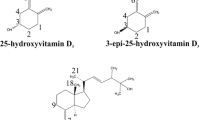Abstract
A method is described to prepare inexpensive organic reference materials for routine stable isotope work. The method blends isotope-enriched and isotope-depleted materials to match closely international measurement standards. Examples are presented showing how 13C-enriched and 13C-depleted glucose were blended to match the isotopic compositions of the international carbon isotope standards, NBS 19 and L-SVEC. Preparation of the blended standards was straightforward, and the prepared solutions proved easy to dispense into tin capsules and easy to combust in a conventional isotope analysis system. The blended materials allow a laboratory to perform a two-point calibration for isotopic composition on a daily basis, with the use of an international reference material recommended for routine quality assurance. The blending method can be applied widely to make isotope standards for other elements and compounds.

Similar content being viewed by others
Notes
It is also important that RMs are easy to handle, non-hygroscopic and chemically similar to routine samples.
Close bracketing may be appropriate if memory effects in the sample preparation lines are substantial.
References
Qi H, Coplen TB, Geilmann H, Brand WA, Böhlke JK (2003) Two new organic reference materials for δ 13C and δ 15N measurements and a new value for the δ 13C of NBS 22 oil. Rapid Commun Mass Spectrom 17(22):2483–2487. doi:10.1002/rcm.1219
Coplen TB, Brand WA, Gehre M, Gröning M, Meijer HAJ, Toman B, Verkouteren RM (2006) New guidelines for δ 13C measurements. Anal Chem 78(7):2439–2441. doi:10.1021/ac052027c
Skrzypek G, Sadler R, Paul D (2011) Error propagation in normalization of stable isotope data: a Monte Carlo analysis. Rapid Commun Mass Spectrom 24(18):2697–2705. doi:10.1002/rcm.4684
Coplen TB, Bohlke JK, DeBievre P, Ding T, Holden NE, Hopple JA, Krouse HR, Lamberty A, Peiser HS, Revesz K, Rieder SE, Rosman KJR, Roth E, Taylor PDP, Vocke RD Jr, Xiao YK (2002) Isotope-abundance variations of selected elements (IUPAC Technical Report). Pure Appl Chem 74(10):1987–2017
David GE, Coxon A, Frewa RD, Hayman AR (2010) Isotope fractionation during precipitation of methamphetamine HCl and discrimination of seized forensic samples. Forensic Sci Int 200(1-3):123–129. doi:10.1016/j.forsciint.2010.03.043
Author information
Authors and Affiliations
Corresponding author
Electronic supplementary material
Below is the link to the electronic supplementary material.
ESM 1
(PDF 638 KB)
Rights and permissions
About this article
Cite this article
Carter, J.F., Fry, B. “Do it yourself” reference materials for δ 13C determinations by isotope ratio mass spectrometry. Anal Bioanal Chem 405, 4959–4962 (2013). https://doi.org/10.1007/s00216-013-6851-z
Received:
Revised:
Accepted:
Published:
Issue Date:
DOI: https://doi.org/10.1007/s00216-013-6851-z




